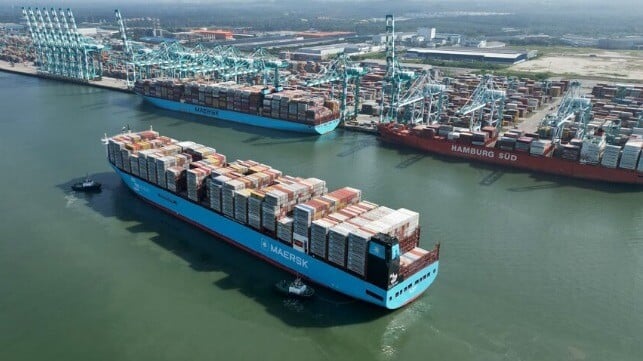Maersk Disappoints Investors, Points to Continued Challenges in Shipping

Despite reporting better than expected third quarter results and narrowing the range for its yearly income estimate, investor concerns continue to grow on the container shipping segment as Maersk pointed to continuing issues. While it reported strong quarterly results, it was the underlying issues around freight rates that raised the greatest concern for Maersk and the industry more broadly.
Among the first of the large, publicly traded container carriers to report financial results, Maersk’s reports draw broad attention as a bellwether for the segment and global economy. In good news for the industry, speaking with reporters, Maersk CEO Vincent Clerc dismissed the talk of “de-globalization” and changes in trade patterns due to the trade wars and tariffs. He pointed to the continued high volumes during the quarter, as well as strong performance in its terminal operations and improved margins for the logistics businesses.
Maersk experienced a seven percent increase in its volumes during the third quarter, highlighting the strong exports from East Asia and China. It also pointed to the success of the Gemini Cooperation with Hapag-Lloyd, which it said enables cost savings and supports the volume growth with industry-leading reliability. It said it had experienced sequential growth across all its business segments while saying the company is well-positioned to help customers adapt and maintain stability across their supply chains.
After starting 2025 with a pessimistic outlook that foresaw a potential decline in container market volume growth, Maersk has raised its forecast several times. Today it is it forecasts four percent growth for the year, revised from a previous interim estimate of two to four percent.
The main factor impacting the company’s financial performance was freight rates. While rates were largely stable versus the prior quarter, they continued a step decline versus the year ago. Average freight rates were down by nearly a third (31 percent). The company was able to offset some of these declines with cost savings and lowered fuel costs.
Freight rates, Clerc reported, had fallen during the third quarter below Maersk’s breakeven level. Although the rates appeared largely stable, the outlook is for rates to continue forward at similar levels, putting pressure on the company’s financial performance. During the third quarter, revenues from the ocean division were off 18 percent versus last year. The overall company reported a significant drop in income (EBIDTA) during the third quarter.
Another factor that it said is likely to impact results is “huge uncertainty” from the containership orderbook. Clerc echoed the concerns of many investors and industry executives about how the new ship deliveries will impact the industry over the next three years. He also said that the rerouting away from the Red Sea would continue for the remainder of the year. Analysts have speculated that the return to routes through the Red Sea would create excess capacity, which could weigh on freight rates going forward.
Based on the nine-month results, Maersk narrowed the range for its full-year estimates for earnings (EBITDA and EBIT). After starting 2025 with the low end of the range for EBITDA at $6 billion, the company again raised the low end from $8 billion to $9 billion for the year while maintaining the high end of the range at $9.5 billion.
Concerned about the outlook and disappointed that the company had not increased its income forecasts for 2025, investors drove the share price of Maersk down approximately five percent. Maersk does not provide forecasts for the year ahead until reporting year-end results in early 2026.
